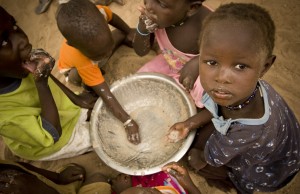Though it hasn't received much news coverage here in the United States, there's another part of Africa facing a food crisis. This time it's the Sahel region that stretches across the continent between the Sahara and the lusher areas to the south that's feeling the effects of drought, rising food prices, and in some areas, conflict and locusts.
It is estimated that about 13 million people are in need after the rains failed last year,

prolonging a drought that has made it difficult for families to grow food in a place where the growing season is already very short. It remains to be seen what kind of rainy season the region will face this year.
Food prices also rose for the third time in three straight months in March, making it that much more difficult for families who have little to pay for the food that with which they would normally supplement their diets.
The U.S. has sent nearly 40,000 tons of sorghum to the region with it's expected arrival at the end of the month. UNICEF is also working to raise awareness of the crisis, particularly through its social media channels. They're right to point out that, like what happened in the Horn of Africa last year, this crisis is preventable.
In Senegal, Heifer has helped the people in this region manage the dry conditions for the past two years, and has prepared them for precisely the kind of situation the region is facing now. Heifer's projects have equipped participants with a short-haired sheep specially suited to area's heat, goats, pigs and seeds that can thrive even in the Sahel soil.
Participants are also spreading manure on the nutrient-depleted soils to replenish them, and planting acacia trees to provide shade and help the soil hold water and not blow away.
It's a long-term solution for an acute problem, yes, but it's providing people with the means to survive and thrive in changing climates and conditions.